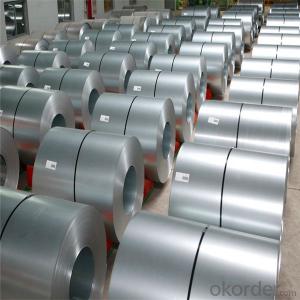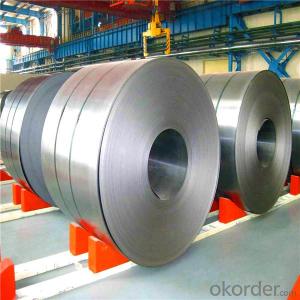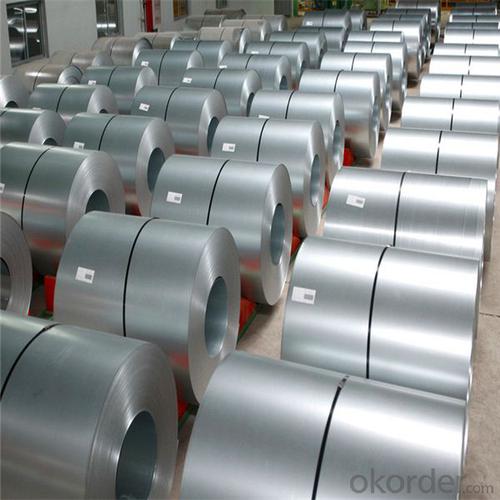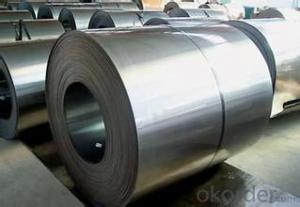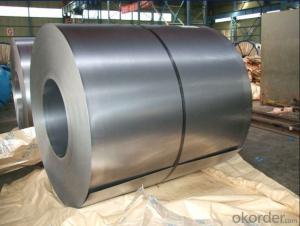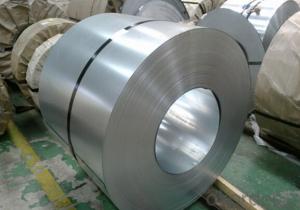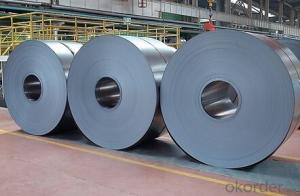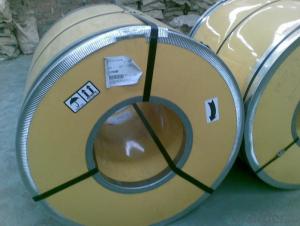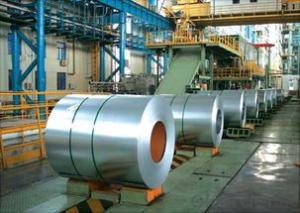Cold-Rolled Steel Coil (JIS G3141-1996, EN 10131-2006, DIN EN 1002)
- Loading Port:
- China main port
- Payment Terms:
- TT OR LC
- Min Order Qty:
- 10 m.t.
- Supply Capability:
- 10000 m.t./month
OKorder Service Pledge
OKorder Financial Service
You Might Also Like
Specification
PERIME COLD ROLLED STEEL COIL
Product Description
Specifications of Cold Rolled Steel Coil:
1)Grade: SPCC, SPCD, SPCE, DC01-06, St12, Super deep drawing2)Standard: JIS G3141-1996, EN 10131-2006, DIN EN 1002
3)Thickness: 0.20mm - 3.0mm
4)Width: 600/1000/1250/1500 (mm) or per customer's request
5)Coil ID: 508mm/610mm or per customer's request
Classification:
Classification | Designation | Characteristics | Size(mm) | Main applications |
Commercial quality | SPCC,SPCCT | Commercial quality suitable for bending fabrication and simple forming; this is the type in greatest demand. | Thickness 0.18-3.0 Width 600-1500 | Refrigerators, cabinets, power distribution boards and drums. |
Drawing quality | SPCD | Drawing quality second only to that of SPCEN. Excellent uniformity. | Thickness 0.18-2.0 Width 600-1250 | Automobile floor and roof panels. |
Deep-drawing quality | SPCE,SPCF | Deep-drawing quality. With metallurgically controlled grain size, it retains its beautiful finish even after being deep-drawn. | Thickness 0.18-2.0 Width 600-1250 | Automobile fenders and quarter panels |
Chemical Components:
Grade | Chemical Components | ||||
C | Mn | P | S | Alt | |
SPCC | ≤0.12 | ≤0.50 | ≤0.035 | ≤0.025 | ≥0.020 |
SPCD | ≤0.10 | ≤0.45 | ≤0.030 | ≤0.025 | ≥0.020 |
SPCE | ≤0.08 | ≤0.40 | ≤0.025 | ≤0.020 | ≥0.020 |
Mechanical Properties:
Grade | Strengh | ||||
YS | TS | Elongation(%) | |||
MPA | δ | S | P | ||
SPCC DC01 | 130-260 | 270-410 | 28 | ||
SPCD DC03 | 120-240 | 270-390 | 34 | ||
SPCE SPCEN | <210 | 270-370 | 38 | ||
DC04 DC05 | <210 | 270-370 | 38 | ||
AISI 1006 | 275-365 | 275-380 | 34 | 32 | 30 |
AISI 1008 | 275-390 | 275-410 | 32 | 30 | 28 |
AISI 1010 | 295-410 | 295-430 | 30 | 29 | 28 |
AISI 1020 | 355-490 | 355-500 | 26 | 25 | 24 |
AISI 1045 | 530-685 | 16 | |||
AISI 1050 | 540-715 | 14 | |||
AISI 1060 | 550-775 | 12 | |||
ST33 S185JR | 185-195 | 315-430 | 33 | ||
ST37 S235JR | 215-235 | 375-500 | 25 | ||
ST37 S355JR | 275-325 | 510-680 | 18 | ||
Thickness Tolerance:
Thickness (mm) | Tolerance allowed(mm) |
0.20-0.50 | +/-0.05 |
0.50-0.65 | +/-0.06 |
0.65-0.90 | +/-0.07 |
0.90-1.00 | +/-0.09 |
1.10-1.20 | +/-0.10 |
1.20-1.40 | +/-0.12 |
1.40-1.50 | +/-0.13 |
1.50-1.80 | +/-0.14 |
1.80-2.00 | +/-0.15 |
2.50-3.00 | +/-0.20 |
Width Tolerance:
Width(mm) | Tolerance allowed (mm) |
≤200 | +2.0/-1.0 |
>200-300 | +2.5/-1.0 |
300-400 | +3.0/-2.0 |
400-600 | +3.5/-2.5 |
600-1000 | +6/-0 |
>1000 | +10/-0
|
- Pickling: To clean the dust and rust points on the surface.
- Cold Rolling: Digital rolling control system produces minimum thickness tolerance, helps to prevent twist and improve straightness.
- Slitting: Precise slitting machinery helps control the best width tolerance and avoid camber or cracker. Also we can make round or sharp edge with additional process and special machines.
- Heat treatment: Advanced annealing, tempering and hardening techniques will help to produce proper mechanical property of the products to insure our client's usage with minimum harm to natural environment.
 Applications for cold rolled Steel Coil:
Applications for cold rolled Steel Coil:1) For the further producing of hot dip galvanized steel products
2) Cold rolled Steel Coil: Auto manufacture, Oil drum, Transformer's tank panel, Furniture etc.
- Q: How do steel coils contribute to fire resistance in buildings?
- Steel coils contribute to fire resistance in buildings by providing structural integrity and stability. The use of steel coils in construction helps in preventing the collapse of buildings during a fire. Steel, being a non-combustible material, does not contribute to the spread of fire, allowing occupants more time to evacuate safely. Moreover, steel coils have high melting points, which means they can withstand intense heat for a longer duration before losing their strength. This property helps in slowing down the fire's progression and gives firefighters more time to control the blaze.
- Q: How are steel coils used in construction?
- Steel coils are commonly used in construction for a variety of purposes, such as creating structural frameworks, reinforcing concrete, and manufacturing various building components like beams, columns, and trusses. The coils are unrolled and cut to specific dimensions, allowing them to be easily shaped and welded into various structural elements. This versatile material provides strength, durability, and flexibility, making it an essential component in constructing buildings, bridges, and other infrastructure projects.
- Q: Can steel coils be used in the manufacturing of machinery and equipment?
- Machinery and equipment manufacturing can indeed utilize steel coils effectively. These coils possess remarkable versatility and contribute strength, durability, and stability to various industrial applications. They can be manipulated to assume various shapes, receive cuts, and undergo formation to generate diverse parts and components that are indispensable to the manufacturing process of machinery and equipment. Gears, shafts, frames, brackets, and other structural elements are commonly produced using steel coils. Moreover, these coils can undergo further processing to fashion specialized components like springs or fasteners. By incorporating steel coils into machinery and equipment manufacturing, the end products are guaranteed to possess exceptional quality, capable of enduring heavy loads, and boasting an extended lifespan.
- Q: What are the common quality issues with steel coils?
- Steel coils commonly have quality issues including surface defects, dimensional variations, mechanical property variations, coating issues, internal defects, edge issues, and coil set or camber. These issues can impact the appearance, performance, processing, and suitability of the final product. To maintain quality, manufacturers employ rigorous inspection, testing, and adherence to industry standards and specifications.
- Q: How are steel coils used in the manufacturing of flooring materials?
- Steel coils are commonly used in the manufacturing of flooring materials as they provide structural support and durability. The steel coils are typically used as a base layer that is sandwiched between other materials, such as wood or vinyl, to create a strong and sturdy flooring surface. The coils help to distribute weight evenly and prevent the flooring from sagging or warping over time. Additionally, the steel coils can also enhance the impact resistance and overall lifespan of the flooring, making it suitable for high-traffic areas.
- Q: should I shoot Herters .308 steel cased ammo in my Remington 7400.and why shouldn't I?
- Kudos to NXile for his/her post. Ironically, I recently posted a similar answer in this forum and got many thumbs down. The problem with the non-expansion of steel cased ammo is not limited to the blow-back and soot build-up inside the action. The other problem is that your Remington 7400 was engineered at the Remington factory as a sporting firearm that uses brass cased sporting ammunition. When you switch to the steel cased ammo, the casing doesn't have a chance to grab at the walls of the chamber to slow it down. The result is heavier recoil on the action of the gun. Over time, you will break something. Also, I don't like the idea of steel rubbing against steel inside the chamber area of a gun. I know sure sure I won't use steel cleaning rods or brushes to clean the barrel of a rifle. So why would I want to chance shooting steel cased ammo? The only stuff I will shoot steel cased ammo out of are the junky SKS and AK style rifles that I don't care about. Anything with real value...and I only use brass ammo with non-corrosive priming.
- Q: What are the different surface treatments for steel coils?
- Steel coils can undergo various surface treatments to achieve different outcomes and applications. Some commonly used treatments include: 1. Hot-dip galvanizing: Steel coils are immersed in molten zinc, which forms a protective layer on the surface. This treatment provides excellent corrosion resistance for outdoor use. 2. Electro-galvanizing: A thin layer of zinc is electroplated onto the steel coils. It offers good corrosion resistance and is suitable for indoor applications. 3. Powder coating: Dry powder is applied to the surface and heated to form a durable coating. It provides excellent corrosion resistance and comes in different colors and finishes. 4. Paint coating: Steel coils can be coated with liquid paint, offering both corrosion resistance and aesthetic appeal. The thickness and finish can be customized according to the desired look and level of protection. 5. Phosphating: Steel coils are immersed in a phosphate solution, creating a thin layer that enhances paint adhesion and improves corrosion resistance. 6. Chromate conversion coating: Steel coils are immersed in a solution containing chromium salts, providing excellent corrosion resistance and acting as a primer for subsequent paint or powder coating. 7. Zinc-nickel plating: A layer of zinc-nickel alloy is electroplated onto the steel coils, offering superior corrosion resistance compared to pure zinc plating and is suitable for demanding environments. These are just a few examples of the many available surface treatments for steel coils. The choice depends on factors such as application, desired corrosion resistance, aesthetic requirements, and budget. It is important to carefully consider project needs and consult with experts to determine the most suitable treatment.
- Q: What are the different methods of coil slitting for precision cuts?
- Coil slitting, a process utilized for cutting large coils of material into narrower strips, is achieved through various methods that offer distinct advantages and suitability for different applications. 1. Rotary Shear Slitting, the most commonly used method, employs rotating circular knives to shear the material and create multiple strips. The distance between the blades can be adjusted to achieve the desired width. This method guarantees high precision with smooth and burr-free edges. 2. Drag Knife Slitting involves the use of a knife with a drag or tangential orientation that follows the material's contour and produces accurate cuts. It is ideal for materials with irregular shapes and finds application in the textile industry to cut fabrics. 3. Scissor Slitting utilizes two blades that move in a scissor-like motion to cut the coil. This method is commonly employed for thinner materials, providing excellent control and precision. It is ideal for materials prone to deformation or wrinkling. 4. Razor Slitting involves the use of a single or multiple razor blades positioned perpendicular to the material. It is particularly effective for cutting stretchy or delicate materials, minimizing the risk of tearing or deforming. 5. Crush Cutting applies pressure from a hardened steel roller or an anvil against a softer material, causing it to deform and split along the desired cutting line. It is suitable for materials that are challenging to cut with sharp blades, delivering precise and clean cuts. In conclusion, the choice of coil slitting method depends on the material, desired precision, and specific application requirements. Each method offers unique benefits and can be tailored to meet specific cutting needs, ensuring accurate and efficient coil slitting processes.
- Q: In terms of weight to strength titanium is stronger. But is it stronger than mild steel? If it is stronger, how much stronger is it?
- The tensile strength of mild steel is about 70kpsi. Pure titanium is 60-110kpsi, and with 7% manganese it is 130-170kpsi. 1kpsi = one thousand pounds per square inch. So in other words, high grade titanium can be somewhat stronger than mild steel.
- Q: What are the common applications of hot-rolled steel coils?
- Hot-rolled steel coils possess distinctive characteristics and versatility, making them widely utilized in diverse industries. The following are some of the common uses of hot-rolled steel coils: 1. Automotive industry: Extensively employed in the automotive sector, hot-rolled steel coils are ideal for manufacturing components such as frames, doors, hoods, wheels, and chassis due to their strength and formability. This enables the production of durable and lightweight automotive parts. 2. Construction sector: Hot-rolled steel coils are widely employed in construction projects to manufacture structural components like beams, columns, and trusses. Their high strength and ductility make them suitable for withstanding heavy loads and providing structural stability. 3. Manufacturing industry: The manufacturing sector utilizes hot-rolled steel coils to produce a wide range of products including machinery parts, pipes, tubes, and equipment. Hot-rolled steel's excellent machinability and weldability allow for easy fabrication and customization according to specific manufacturing requirements. 4. Energy sector: The energy sector employs hot-rolled steel coils to manufacture pipelines, tanks, and other infrastructure required for oil and gas exploration, transmission, and storage. Hot-rolled steel's corrosion resistance and strength make it a preferred choice for such applications. 5. Appliances and furniture industry: Hot-rolled steel coils are used in the manufacturing of appliances such as refrigerators, ovens, and washing machines, as well as furniture components like frames and supports. The aesthetic appeal, durability, and cost-effectiveness of hot-rolled steel make it a popular choice in these industries. 6. Shipbuilding industry: The shipbuilding sector extensively relies on hot-rolled steel coils for constructing components like hulls, decks, and bulkheads. Hot-rolled steel's high tensile strength and corrosion resistance ensure the durability and longevity of ships in harsh marine environments. 7. Infrastructure and bridge construction: Hot-rolled steel coils are utilized in the construction of bridges, highways, and other infrastructure projects. The high strength and load-bearing capacity of hot-rolled steel make it suitable for supporting heavy traffic and withstanding dynamic loads. In conclusion, hot-rolled steel coils are utilized in various industries including automotive, construction, manufacturing, energy, appliances and furniture, shipbuilding, and infrastructure. The unique properties of hot-rolled steel, such as high strength, formability, and versatility, make it an indispensable material for a wide range of applications.
Send your message to us
Cold-Rolled Steel Coil (JIS G3141-1996, EN 10131-2006, DIN EN 1002)
- Loading Port:
- China main port
- Payment Terms:
- TT OR LC
- Min Order Qty:
- 10 m.t.
- Supply Capability:
- 10000 m.t./month
OKorder Service Pledge
OKorder Financial Service
Similar products
Hot products
Hot Searches
Related keywords
